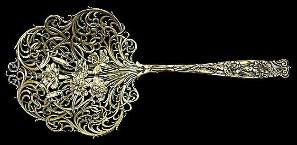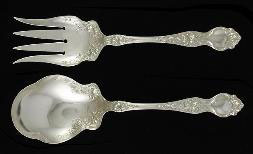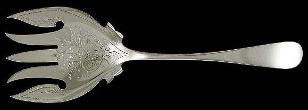
Why Silver Tarnishes
Silver tarnishes when it is exposed to sulfur, which is in the atmosphere all around us. Humidity accelerates tarnishing, so if you live in a humid environment or even have a humidifier in your home, you will be polishing your silver more often than if you lived in an arid environment.
Certain food items can cause spotting on silver, so extra diligence should be paid when washing and drying utensils that have come into contact with these foods. Such foods are eggs and foods that contain eggs such as mayonnaise; acidic foods such as vinegar, ketchup, mustard, salad dressing, onions, and fruit juice; and salt. Short term exposure is not a problem. Rubber bands and latex products also contain sulfur, so care should be taken to keep silver away from these items.
Long term exposure to the foods and items mentioned above, such as leaving granules of salt on a fork or bundling your spoons with rubber bands, will corrode the silver. The longer the exposure, the worse the damage. Oftentimes the darkening and pitting cannot be removed with silver polish, but must be taken to a professional to have the damage machine buffed or ground out.

Preventing Tarnish
The best way to keep your silver flatware from becoming tarnished is to use it regularly. Frequent use and hand washing will keep it shiny, bright, and tarnish-free. When you do use it, rotate it. For example, if you have a setting for twelve and normally use four at a family meal, use a different set of four pieces each time. Make it a habit to use the forks, spoons, etc. in a stack, but put them away after washing on the bottom.
If you prefer to store your silver, the best way to do this is in a silverware chest designed for this use. The interior surfaces of silverware chests are lined with special anti-tarnish material and should keep your silver tarnish-free for years.

Washing Your Sterling Flatware
Sterling flatware should be washed by hand and dried by hand. Avoid dish soaps with lemon juice in them or a lemon scent. Silver can be air dried, if you don’t mind occasional water spots. If you have a stainless steel sink, it is best to put a towel down in the bottom of the sink to prevent the silver from scratches. Use a soft sponge or brush; do not use a scrubber-type sponge as it can leave unsightly scratches.
Sterling should never be put in the dishwasher. Dish washing detergent is very corrosive, and the same way your glassware eventually turns cloudy or your fine china loses its gold trim, the detergent will do harm to your silverware. Over time, your silver will lose its luster and take on a flat, whitish appearance. Knives in the dishwasher are especially vulnerable in the high heat drying cycle and can suffer an even worse fate: handles can split and blades may become loose. Additionally, some flatware patterns have oxidation applied to them at the time of manufacture, and this oxidation will eventually disappear with continued dishwasher use, altering the look of your flatware forever.

Polishing
Eventually you may need to polish your silver. The best time to do this is when you first notice the silver beginning to darken. You will want to use a mild, low abrasive polish such as Goddard’s Silver Foam. Silver that is more heavily tarnished polishes the quickest with a slightly more abrasive polish, such as Maas or Wright’s. For very dark tarnish, Maas usually works the best. Stainless steel blades may also occasionally become stained, discolored, or even rusty, and Maas or any good metal polish should clean them up nicely.
All flatware should be polished lengthwise. Put a small amount of polish onto a clean cotton cloth (an old tee shirt or towel is perfect) and rub it onto the silver until you can see that the tarnish is gone. Keep in mind that very dark tarnish in the nooks and crannies of certain flatware patterns can be a very desirable thing to have. Manufacturers design patterns knowing some areas will oxidize and get dark with age, thereby enhancing the intricate detail of the pattern. Buff with another clean cotton cloth until polish is removed. Finally, wash, dry and enjoy your newly lustrous silver.
Never, ever use dips, sprays, or the “aluminum foil and baking soda in the sink” routine to clean your silver. These methods will end up doing more harm than good, plus they will eliminate that highly desirous oxidation mentioned earlier. Toothpaste should also be avoided as it is highly abrasive.

